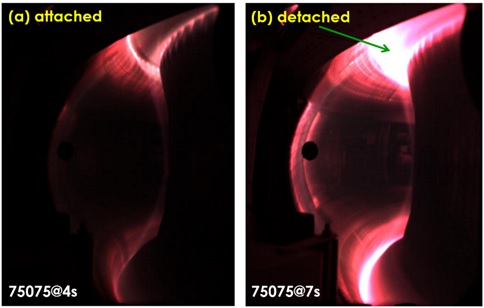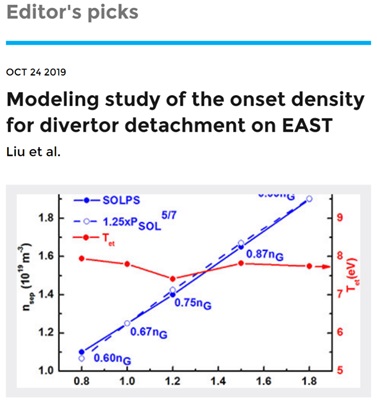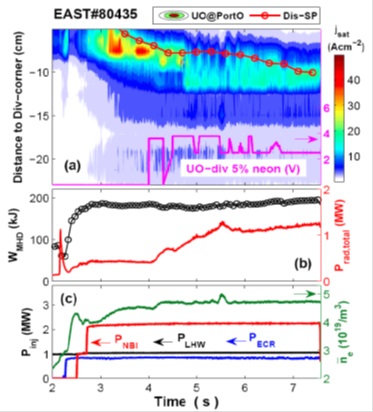
count: [2019-11-04] [Close]
EAST team with Institute of Plasma Physics under Hefei Institutes of Physical Science recently achieved a steady-state high confinement detachment in H-mode plasmas in EAST with ITER-like tungsten divertor. Their work were published in Nuclear Fusion and the modeling study of divertor detachment has been highlighted as an Editor’s Pick in the Physics of Plasma.
High particle and heat fluxes onto plasma facing components (PFCs), especially the divertor targets, is one of the most important issues for high power long pulse operation of fusion devices. The detached divertor operation, as characterized by a strong reduction of both heat/particle fluxes, offers the most plausible solution to these issues for future reactor size devices, such as ITER/CFETR.
Relying on detached divertor operation to keep target heat loads at manageable levels is one of the most critical issues for ITER operation and will need to be robust and reliable.
The radiative divertor feedback control has been developed in 2018 EAST campaign. Based on the method of radiative control, the EAST divertor working group led by WANG Liang has pushed the work further to achieve the real-time feedback control of divertor detachment for the first time in EAST ELMy H-mode discharges with D2 fueling and divertor neon impurity seeding, respectively.
Significant progress has been made in EAST on the physics understanding and active control of divertor detachment for steady state power and particle exhaust, achieving long pulse H-mode operation with ITER-like W divertor. Increasing heating power, especially for the fraction of RF power, increased the electron temperature at the upstream, and rendered it more difficult to achieve the divertor detachment in H-mode discharges.
Their work also revealed that the underlying physical mechanism responsible for the asymmetry of divertor detachment may be attributed to drift effects. In parallel, a number of approaches have been taken for both fueling and impurity particle control to facilitate long pulse operation, including strike point optimization, extensive wall conditioning and long-time first wall baking, coupled with strong pumping. The feedback control of detachment showed good compatibility with the core plasma, thus providing a very promising tool for divertor heat flux control for high power long pulse H-mode operation in the future.
The onset density of detachment for L-mode discharges on EAST has also been studied using the SOLPS code.
The modeling showed that the effect of divertor closure on the the density threshold was qualitative agreement with the results in experiments. The simulation also indicated that the detachment density increased significantly with PSOL as expected, and it could be approximately scaled by PSOL5/7, which was in accordance with the basic two-point model.
The team also found that the improvement of impurity screening in the divertor region became extremely critical to enhance the compatibility of radiative detachment scenarios with high core plasma performance for future reactors with large heating power.
In addition, the Ne-seeded radiative divertor experiment was also validated by SOLPS-ITER code on EAST. The simulation results basically agreed well with the previous experiment.
The research may provide a potential new solution for solving the high heat load problem of the fusion reactor and realizing the steady state operation of the fusion reactor, such as ITER/CFETR. Further efforts are needed for further understanding the underlying physics mechanism of detachment and extending active feedback control towards long-pulse H-mode detachment maintenance in the near future.
The work is the result of EAST team’ cooperation, long-term international and domestic collaboration. Scientists from General Atomics has participated and supported the research. This work was supported by National Key Research & Development Program of China, National Natural Science Foundation of China et al. (LIU Jianbin reports)
Article links:
J. B. Liu et al., NF 2019: https://doi.org/10.1088/1741-4326/ab4639
X. J. Liu et al., PoP 2019: https://doi.org/10.1063/1.5110959
L. Wang et al., NF 2019: https://doi.org/10.1088/1741-4326/ab1ed4
J. B. Chen, Z. S. Yang* et al., PoP 2019: https://doi.org/10.1063/1.5085892
K. Wu, Q. P. Yuan* et al., NF 2018: https://doi.org/10.1088/1741-4326/aab506


